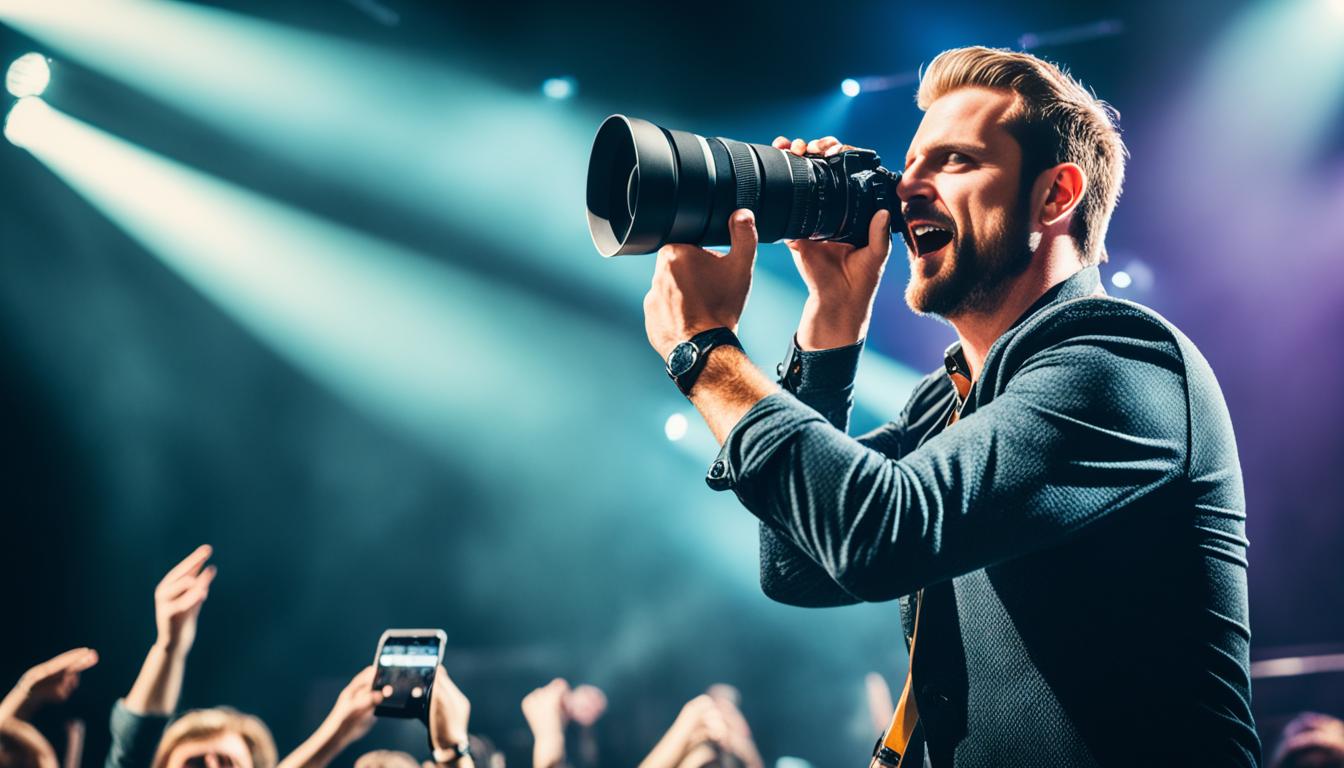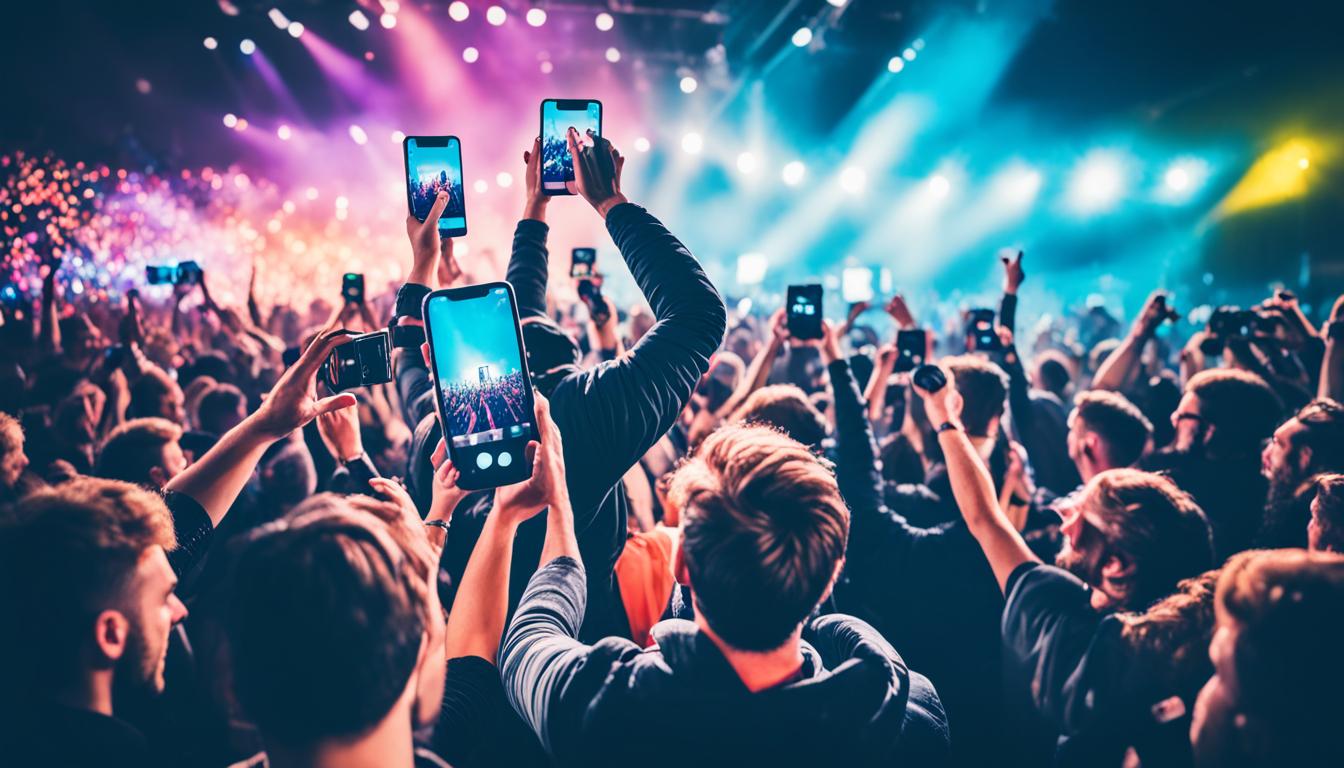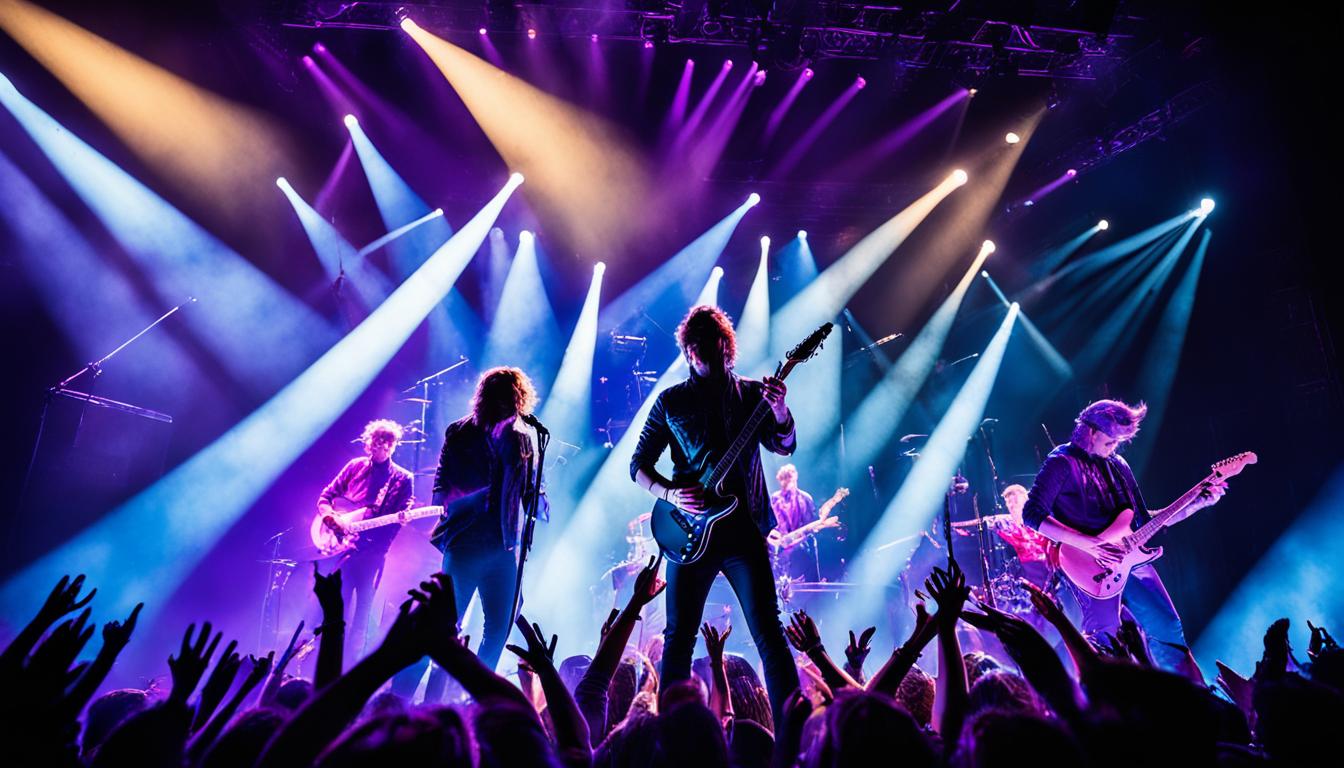Welcome to our guide on concert photography etiquette and best practices. Here, we explore how to capture live concert photography’s essence. In the busy world of music events, our goal is to capture those fleeting moments respectfully. We’ll share how to navigate crowded photo pits and capture the performers’ energy with care. Let’s dive into the rules that make our photography passion complement the live music vibe.
This guide takes you through the lively stages of a music event. We share tips from industry experts for taking great concert photos. These guidelines come from pros who have mastered their skills. Whether you’re new or have lots of experience, you’ll find valuable advice here for concert photography success.
Key Takeaways
- Recognize the importance of concert photography etiquette for a professional and respectful music event environment.
- Apply best practices to effectively capture the vibrant energy of live music while maintaining professionalism.
- Understand the unique challenges of live concert photography and how etiquette plays a pivotal role in managing them.
- Learn invaluable photography tips from seasoned professionals on capturing dynamic concert moments.
- Commit to a standard of conduct that reflects positively on you as a professional photographer within the industry.
- Discover strategies that foster cooperation and respect in the often-cramped quarters of the photo pit.
- Engage with these practices to not only enhance your portfolio but to contribute to the integrity of the concert photography community.
Understanding the Dynamics of Live Concert Photography
Live concert photography is a dance of capturing stunning photos and following stage etiquette. Every photographer knows the thrill of a live show. Yet, it’s our deep knowledge of photography tips that makes our work stand out.
It’s all about positioning – being in the right place at the right moment. We keep our eyes open, watching the crowd and the artists. Being aware of our surroundings is key in the photo pit, where every second matters.
Working together with other photographers helps everyone get their best shot.
Striking the Right Balance Between Persistence and Politeness
We balance assertiveness with courtesy in our work. This balance helps us maintain professionalism. It also lets us capture the true spirit of the music events we document.
Navigating the Photo Pit: Spatial Awareness and Cooperation
In the photo pit, we move with awareness, respecting each other’s space. Our time in the spot is short but meaningful. Our movements, though planned, feel spontaneous. This creates a shared experience among us photographers.
Leveraging Expertise: Lessons from Seasoned Music Photographers
Lessons from experienced photographers teach us more than just camera skills. They’re about respecting the craft and each other. Our photos are more than images; they capture cultures and celebrations through collaboration.
Maintaining Professionalism as a Music Event Photographer
As professional photographers, we have a big job. We must keep high photography etiquette standards at the thrilling live concert photography events. Our behavior shows our professionalism and our respect for the craft and the occasion. To do well in capturing a music event, we must follow key practices that show our readiness and politeness.
- Understanding the “three-song rule” and sticking to it is crucial for any professional photographer. This rule lets us take pictures during the first three songs from the pit. It gives us enough chance to shoot without taking too much time.
- Knowing when and how to use flash is key to photography etiquette. Flash is usually not allowed at live shows because it can bother performers and the audience. Being subtle and smart in our approach is part of our professional identity.
- Handling our gear carefully also marks us as professionals. Using a compact belt or waist bag for our equipment helps us move freely. It shows we’re thoughtful of other photographers and the audience.
Being professional means not getting in the way. We move deliberately, aware of the space we use and the shots we take. We’re always mindful of the concertgoers’ experience and the ongoing performance.
In summary, our professionalism at live concert events involves a respectful balance. It’s about being considerate of our colleagues, the artists, and the venue’s rules. This balance builds our reputation as trusted photography etiquette practitioners at every music event.
Concert Photography Etiquette and Best Practices
We, as professional photographers, hold ourselves to high standards at music events. These standards help us show our professionalism and respect for the stage and its artists. We will explore how to keep respect in all actions and the best ways to move and position ourselves.
Prioritizing Respect in Every Interaction
Respect is key in our community. Whether at a small club or a big festival, our goal stays the same. We aim to create a respectful atmosphere for everyone. Sticking to stage etiquette shows our dedication to our work.
Every snapshot is a synergy of art and discipline, where best practices meet the creative impulse.
We stand against discrimination or harassment, making a space where we focus on our love for concert photography. This is our united aim for a respectful photography culture.
Sharing the Space: Photographer Positioning and Movement Strategies
At a live concert, moving and positioning need careful thought. We follow unwritten rules in the photo pit. Being quick and courteous with our cameras and manners is essential.
- Always communicate with a nod or a gesture before moving to a new position.
- Keep gear to a minimum to minimize impact on others’ space.
- Swap spots with fellow photographers to ensure everyone gets their shot.
By sharing space, we capture the concert’s spirit and show respect for fellow photographers. Now, let’s look at positioning do’s and don’ts in the photo pit.
| Best Practice | Reason |
|---|---|
| Interval Positioning | Allows photographers to take turns in the prime spot. |
| Staying Low | Reduces visual obstruction for the audience and other photographers. |
| Respecting the Three-Song Rule | Ensures equal shooting opportunities within the limited time frame. |
As music event photographers, we follow a path of respect, teamwork, and professionalism. Following etiquette shows our respect for live performance. It’s part of our mission to capture its beauty.

Essential Photography Equipment and Setting Adjustments for Concerts
In concert photography, every click is key. This is why the right photography equipment is crucial for capturing stage moments. A fast lens lets us take clear photos in low light. We use lenses with a wide aperture, from f/1.2 to f/2.8, to shoot without flash in dark venues.
| Photography Equipment | Advantages | Ideal Usage Scenario |
|---|---|---|
| Fast Lens (f/1.2 – f/2.8) | Great low-light performance, creates beautiful bokeh | Low-light concerts where flash is prohibited |
| High ISO Capable Camera | Increase sensitivity to light, permits faster shutter speeds | Capturing high-speed action in dimly lit settings |
| Monopod or Handheld Stabilizer | Reduces camera shake, improves shot stability | Long-hour events and crowded photo pits |
We trust the latest mirrorless cameras with high ISO for less grain and crisp images. Understanding the exposure triangle—ISO, shutter speed, and aperture—is key. We quickly adjust these to fully capture the live performance.
- ISO: Adjust based on ambient light, keeping it as low as possible
- Shutter Speed: Fast enough to freeze motion
- Aperture: Set wide to allow more light for a sharper focus
But, our work isn’t done after the shot. Post-production is vital. Here, lighting techniques and noise reduction make the stage outfit shine as much as the performance. It’s a mix of tech and skill, where we blend each aspect to capture life’s rhythm.

Conclusion
In the world of concert photography, we mix technical skills with soft skills. Our goal is not just to take great photos. We also focus on respecting those around us. This respect shows in every photo we take, proving our professionalism and ethics.
Our work adds to the concert, not just by capturing moments, but also by how we act. Being mindful and careful makes as much impact as the photos. Our dedication to these values earns us respect from others in the music scene.
We end this guide with a promise to keep improving. Let’s keep making concert photography better together. We aim for sharp photos, smooth moves, and respectful actions. This way, our photos don’t just look good; they show we’re serious about our art.
FAQ
What are the basic rules of concert photography etiquette?
Key rules of concert photography etiquette include respecting everyone. This means following the “three songs, no flash” rule. Also, do not block fans’ views, share space with other photographers, and follow the venue’s rules.
How do you balance being persistent in getting good shots and being polite to others at a concert?
Balancing persistence and politeness means knowing when to shoot and when to wait. It’s key to be both assertive and respectful. Share prime spots with others, always watch your surroundings so you don’t ruin the concert for others.
What are some spatial awareness tips for navigating the photo pit?
In the photo pit, staying alert and aware is crucial. Don’t block others’ shots and be polite when moving around. Also, limit how long you stay in one spot to give everyone a chance. Keeping your gear minimal helps save space.
Could you share some wisdom from veteran music photographers on concert photography?
Veteran music photographers highlight the need to know the show and lighting patterns. They emphasize being ready for key moments and building relationships with the crew. They also suggest learning about your camera to quickly adapt to different lighting.
How can photographers maintain professionalism at a music event?
Photographers maintain professionalism by being on time, dressing right, and being prepared. Respecting the performers, following event photography rules, and treating fellow photographers well is also important.
Why is mutual respect crucial in concert photography?
Mutual respect is key for a good working environment. It gives everyone, no matter their background or gear, a fair chance to capture the moments they need without conflict.
How should photographers manage their movement around the stage and photo pit?
Photographers should move mindfully, avoiding sudden or noisy actions. They might need to crouch or kneel to stay out of the way, move quietly, and respect everyone in the area.
What type of equipment should photographers bring to a concert, and how should they adjust camera settings for challenging lighting?
Photographers should use a high ISO capable camera, fast lenses, and consider multiple bodies to limit lens changes. For challenging lighting, increase the ISO, use wide apertures, and select a fast shutter speed. This keeps images sharp without disruptive flash.
What are the “three songs no flash” rule and its significance?
The “three songs no flash” rule limits photographers to the first three songs of a set without flash. It helps minimize distractions for performers and the audience at the show’s start.
How important is non-disruptive behavior in concert photography?
Being non-disruptive is critical. Concert photographers should capture the event without changing the performance or the audience’s enjoyment. Respectful and discreet actions show professionalism and integrity.



